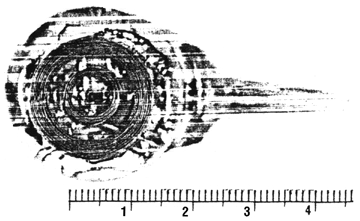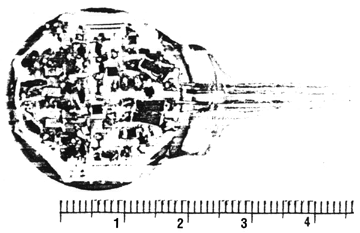PHYSICAL CONTROL OF THE MIND
Toward a Psychocivilized Society
Jose M. R. Delgado, M.D.
Director of Neuropsychiatry at Yale University Medical School
Two-way Radio Communication with the Brain (Pgs. 89 - 96)
"....it is already possible to equip animals or human beings with minute instruments called "stimoceivers" for radio transmission and reception of electrical messages to and from the brain in completely unrestrained subjects. Microminiaturization of the instrument's electronic components permits control of all parameters of excitation for radio stimulation of three different points within the brain and also telemetric recording of three channels of intracerebral electrical activity.It is reasonable to speculate that in the near future the stimoceiver may provide the essential link from man to computer to man, with a reciprocal feedback between neurons and instruments which represents a new orientation for the medical control of neurophysiological functions. For example, it is conceivable that the localized abnormal electrical activity which announces the imminence of an epileptic attack could be picked up by implanted electrodes, telemetered to a distant instrument room, tape-recorded, and analyzed by a computer capable of recognizing abnormal electrical patterns. Identification of the specific electrical disturbance could trigger the emission of radio signals to activate the patient's stimoceiver and apply an electrical stimulation to a determined inhibitory area of the brain, thus blocking the onset of the convulsive episode.
One of the limiting factors in these studies was the existence of wires leading from the brain to the stimoceiver outside of the scalp. The wires represented a possible portal of entry for infection and could be a hindrance to hair grooming in spite of their small size. It would obviously be far more desirable to employ minute instruments which could be implanted completely beneath the skin. For this purpose we have developed in our laboratory a small three-channel stimulator which can be placed subcutaneously and which has terminal leads to be implanted within the brain (Figure 6). The instrument is solid state, has no batteries, and can work indefinitely. Necessary electrical energy, remote control of parameters of stimulation, and choice of channels are provided by transdermal coupling, using a small coil which is activated by frequency-modulated radio signals.
The technology for nonsensory communication between brains and computers through the intact skin is already at our fingertips, and its consequences are difficult to predict. In the past the progress of civilization has tremendously magnified the power of our senses, muscles, and skills. Now we are adding a new dimension: the direct interface between brains and machines. Although true, this statement is perhaps too spectacular and it requires cautious clarification. Our present knowledge regarding the coding of information, mechanisms of perception, and neuronal bases of behavior is so elemental that it is highly improbable that electrical correlates of thoughts or emotions could be picked up, transmitted, and electrically applied to the suitable structure of a different subject in order to be recognized and to trigger related thoughts or emotions. It is, however, already possible to induce a large variety of responses, from motor effects to emotional reactions and intellectual manifestations, by direct electrical stimulation of the brain. Also, several investigators have learned to identify patterns of electrical activity (which a computer could also recognize) localized in specific areas of the brain and related to determined phenomena such as perception of smells or visual perception of edges and movements. We are advancing rapidly in the pattern recognition of electrical correlates of behavior and in the methodology for two-way radio communication between brain and computers.
Fears have been expressed that this new technology brings with it the threat of possible unwanted and unethical remote control of the cerebral activities of man by other men, but as will be discussed later, this danger is quite improbable and is outweighed by the expected clinical and scientific benefits. Electronic knowledge and microminiaturization have progressed so much that the limits appear biological rather than technological. Our greatest need is for more experimental information about the neuronal mechanisms related to behavioral and mental processes, and research in unrestricted subjects promises to reveal new understanding of normal minds and more efficient therapy of disturbed brains.
Figure 6
Both sides of a three-channel transdermal stimulator. This instrument has no batteries, is activated by radio, and can be used for life, so that the brain can be stimulated indefinitely.
Refs
HedWeb
Roborats
Orgasmatrons
Hypermotivation
Empathogens.com
The Orgasmic Brain
Wirehead Hedonism
The Good Drug Guide
Utilitarianism On The Net
The Hedonistic Imperative
Critique of Brave New World
When Is It Best To Take Crack Cocaine?
Wireheads and Wireheading in Science Fiction
dave@bltc.com


